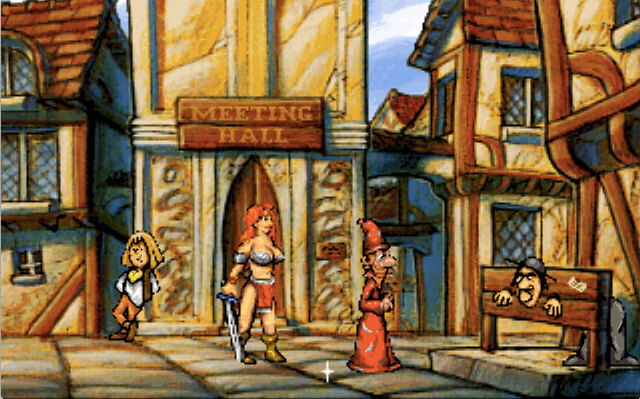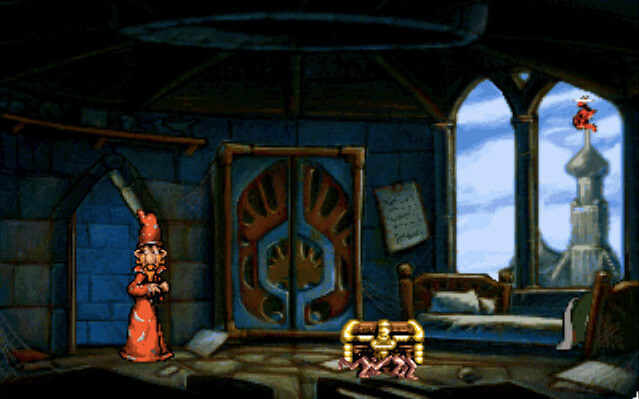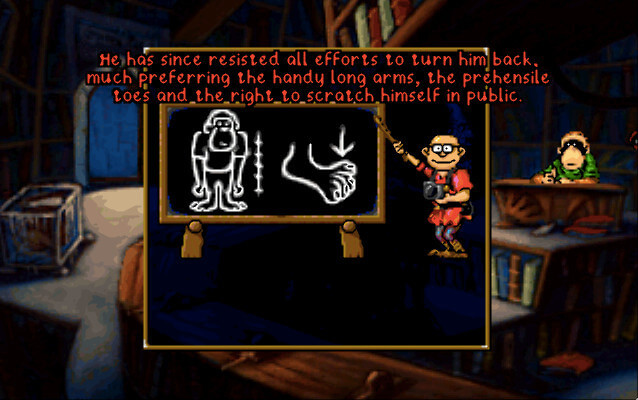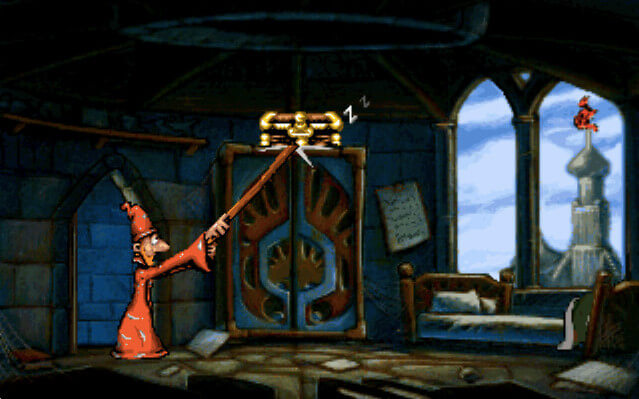by Jay
- 7 minute read - 1453 wordsThe header image for this post was created by DeviantArt user Bezduch
Back in the late 90s Squidgey and I had a PlayStation and a big stack of games and demo disks. This was before internet based console gaming, which was started by the DreamCast.
Even though there had been experiments with the Sega Channel before it, for the Genesis/Mega Drive. During the late 90s and into the early 2000s, demos were distributed on disks which were attached to the covers of gaming magazines.
Which is yet another industry which seems to be on it’s way out.
I’m pretty sure that Discworld was on one of those demo disks, or it was a borrowed game. I don’t remember buying it when we first played it, but I could just be mis-remembering.
The Game
Discworld was a PC game developed by Teeny Weeny Games and Perfect 10 Productions. It was ported MacOS (1995), PlayStation (1996) and Sega Saturn (1996); and is based on the Discworld series of books by Terry Pratchett. Discworld is a point and click adventure game, in the style of the LucasArts SCUMM games – in fact it uses the SCUMMVM engine.
It, very loosely, follows the plot of Guards! Guards! (with a little of Moving Pictures thrown in for good measure) but replaces Samuel Vimes with Rincewind as the hero of the story.
If it isn’t obvious when reading this post, both Squidgey and I are big Discworld fans.
There’s no romantic subplot between the hero and Sybil Ramkin, and the Watch aren’t as prominent as in the book.
Guards! Guards! is the first Discworld novel that focuses on the City Watch – who are the Ankk-Morpork police force.
The (basic) Plot
Dragons!
Or rather dragon.
Someone has summoned a dragon, and it is terrorising the city. The wizards at Unseen University take it upon themselves to figure out where the dragon came from, and to stop it. Of course, the wizards are fantastic at delegation and have delegated these tasks to Rincewind the wizard (in training).
Rincewind is a pretty terrible wizard, with only one qualification to his name: Thaumaturgy 101 – failed.
Rincewind has to solve a series of useless point and click adventure ques… I mean “lateral thinking exercises”
to quote one of the many fourth wall destroying scenes in the sequel
There are time travel elements, dragons, and a whole cast of Pratchett characters to meet (including Zorgo, the retrophrenologist, and Conina the barbarian warrior princess who just wants to be a hairdresser, along with lots of others).
(Main) Characters
There’s the aforementioned Rincewind the wizard. His Unseen University room number is 7a. This is for a variety of reasons, the least of which being the 8 is a very dangerous number to Wizards. 8 is the number of Bel-Shamaroth – the soul eater – and by mearly mentioning it, you run the risk of attracting Bel-Shamaroth’s attention.
You don’t learn this in the game, but it’s a fun fact about him.
He is unable to remember any spells that he has to learn. This is because, as an undergraduate student he’d sneaked into a room which contained the Octavo – a book with the rawest of all magic spells in it, which is chained down to its pedestal to stop it from escaping on its on volition – and one of the spells in it had lodged itself in his brain, leaving Rincewind unable to learn any other magic spells. Presumably because they were scared of the unspoken spell from the Octavo.

A screenshot showing Conina, Rincewind, and The Tax Collector
His constant companion is The Luggage: an anthropomorphic old timey chest (like you would see in a Pirate Film) with hundreds of legs which follows Rincewind around. The Luggage behaves a little like a dog, and acts as the games inventory (Rincewind can store all of the items he picks up on his quest in The Luggage).
Rincewind describes the luggage as
it had an elemental nature, absolutely no brain, a homicidal attitude towards anything that threatened its master, and he wasn’t quite sure that its inside occupied the same space-time framework as its outside

A screenshot showing Rincewind, The Luggage, and the Dragon
The UU academic staff are present in the game. These are a collection of Wizards who teach at UU, they also happen to be hundreds of years old.
Death features in the game, too. Although the Discworld version of Death isn’t to be feared, he simply does the job that’s in front of him and wants to learn more about humanity. Giving him a slightly human feel along the way.
Throughout the game, a tourist pops up to explain some of the more esoteric things about the Discworld universe. For example, why the librarian is an Orangutan, or about the geography of Ankh-Morpork.
Those who have read the books might recognise him as Twoflower, from The Colour of Magic and The Light Fantastic

A screenshot showing Twoflower explaining some of the sideways logic of the game
Gameplay
As with the point and click adventure games that this game is influenced by, Discworld is played by investigating Rincewind’s surroundings, clicking on things, chatting with non-player characters and solving puzzles.
It’s a pretty simple formula that was used, to great effect, in the SCUMM games (games like The Secret Of Monkey Island, Grim Fandango, Loom, and Maniac Mansion). If you’ve ever played any of these games, you’ll be in familiar territory. Especially with some of the more interesting puzzles.
For those who haven’t played any of the SCUMM games, you have to click on things to investigate them, this will force Rincewind to walk over and pass commentary on them. You can make Rincewind have conversations with other characters, or take objects and make them interact with other objects or characters.
At the beginning of the game, for instance, you have to use a broom to wake The Luggage. It’s asleep on top of Rincewind’s wardrobe, and you use it to carry all of your items (Rincewind can only carry two items at a time).

A screenshot showing Rincewind attempting to wake The Luggage by bashing it with a stick
You then use the same broom on Windle Poons to get his magical staff.
This magic staff is then later used to build a dragon detecting device, as mentioned in “Featherwinkles Concise Compendium on Dragons Lairs”, which you must get from the Librarian, who refuses to get you the book (because you don’t have a library card) until you bribe him with a banana.
And that’s one of the most simple puzzle chains in the game
Voice Acting
The early SCUMM based games (Maniac Mansion, The Secret of Monkey Island, etc.) where distributed on multiple floppy disks (meaning that you had to swap disks as you progressed through the game or visited different areas), and only had MIDI background music.
But the later SCUMM based games where distributed on CD-ROM. This meant that the developers could have voice actors read the lines out.
Discworld was one of the later games, and had a whole host of voice actors portraying the characters.
Eric Idle provides the voice for Rincewind. Which is alluded to in a forth wall breaking joke:
Archancellor: We’ve no time for Idle chatter
Rincewind: I can’t help who is providing my voice. And we’ll say no more
The other Character’s voices are provided by Rob Broydon, Tony Robinson (famous for playing Baldrick in Blackwater), Kate Robbins, and Jon Pertwee (who played the third Doctor in Doctor Who). They all put in stellar performances as the population of Ankh-Morpork, and Eric Idle’s performance as Rincewind is how I read him when reading Discworld novels to this day.
Unfortunately, this game does suffer from audio levelling issues – some lines are louder than others, and some are quieter than to background music. Id always recommend playing with the subtitles turned on (and the subtitle speed turned down).
Thoughts
Discworld, though not the first game based on the series of novels, is a fun game, with plenty of humour and lots of puns. Although, it’s not for everyone. The puzzles sometime require lateral (and sometimes, sideways) thinking to solve them as they follow the twisted logic of the Discworld itself.
It’s not strictly fair to say that Discworld logic is twisted, it’s more a case of it taking itself too literally. “Dragon’s can’t exist because they don’t exist,” for instance.
Have you ever played any of the Discworld (or SCUMM based) games? Let us know what they were and what you thought of them in the comments and let’s keep the conversation going.